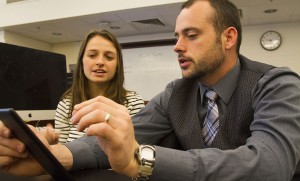
I stand outside a hole-in-the-wall bar in Baltimore, clenching my notebook. In just a few minutes, I’m going to be in the presence of hundreds of years of collective newsroom experience. An amateur reporter profiling seasoned experts. I hope I don’t look clueless. Maybe if I scribble really quickly in my notebook it will look like I know what I’m doing. Yeah, that’s a good plan. I take a deep breath.
At 12 p.m., I tentatively open the door to Roman’s Place. In 30 minutes, the place will be bustling with members of the Aging Newspapermen’s Club. But for now, I’m the only one here, other than the bartender.
Before long, Holton Brown, known as Brownie, who worked as an editorial assistant for the Baltimore Sun for 41 years, shows up and sits next to me. The bartender automatically gets him a Coke – she knows what every member of the club will order before they even look at the menu. They’ve been coming to Roman’s Place every week for over three years. I tell Brownie I’m here to profile the Aging Newspapermen’s Club.
“I just call them, ‘The Geezer’s Club,'” he says, and laughs.
The bartender and Brownie inform me that there are usually anywhere from four to over a dozen people who show up for the club. On some occasions, however, there have been upwards of 60 people, so many that there wasn’t enough space in the restaurant to seat them all.
The club started in 2009 when Rafael Alvarez, who worked at the Baltimore Sun from 1977 to 2001, met with one of his original mentors, Michael Olesker, for lunch at a restaurant called Enrico’s. They started inviting more people from the newsroom to their weekly lunches, and it grew from there. At first there were only men, hence the name, but women soon started showing up. When Enrico’s closed in 2010, they moved to Roman’s Place.
Video by Dani Shae Thompson, who takes an inside look at one of the meetings of the Aging Newspapermen’s Club.
More members begin to arrive, and we move from the bar to the restaurant area in the back. It’s small, with only a couple tables, and tattered beer signs line the walls. The men’s restroom is a tiny outcropping off to the side of the dining area with no lock. There’s a large block of ice in the urinal.
Eleven show up in total, and once they are all present, there is a minimum of three loud conversations happening at any given moment.
“You’re never going to be able to ask anyone any questions,” says Jim Burger, a photographer for the Baltimore Sun for a little over 10 years. He was right. There were no breaks in conversations, just an onslaught of laughing and cursing from the former (and some current) news industry employees around the room.
“Can I get all your names?” I struggle to ask over the conversation. One by one, the members at my end of the table stand up, reach into their wallets, and give me their business cards. I align them into a neat stack next to my notebook.
“Are you writing obituaries?” asks the gentleman sitting across from me. “If so, you’re a few weeks early.”
“Can I get your name?” I ask him.
“No,” he replies. “Who are you writing for?”
“The American Journalism Review,” I respond.
“That’s a respectable publication,” he says, insinuating that my experience with the club would be, well, less-than-respectable. Everyone begins to laugh.
He later tells me his name is Ken Sokolow, and that he was a founding columnist at Baltimore City Paper.
Mike Himowitz, who used to be a reporter and science editor for the Sun, among other positions, offers this: “This is the least respectable bunch of people I’ve ever dealt with.”
“Maybe if you were writing for Al Goldstein’s Screw Magazine I’d give you an in-depth interview, but no,” says Sokolow, laughing.
At one point, Himowitz takes the stage and begins telling a story of when he was medical editor. I perk up, notebook in hand, hoping to get something I could use in my article.
He tells of a woman who had to get her cancerous leg amputated. The doctors accidentally amputated the wrong leg, but since she still had cancer in the other leg, it had to go as well. I am fascinated, scribbling as fast as I could in my notebook.
She sued the doctors, but lost.
“Why?” asks Himowitz. “The judge said she didn’t have a leg to stand on.”
The table erupts into laughter and somebody calls it the oldest joke in the book. I put my pen down in a fit of self-loathing.
Tony Hayes, who says he writes for the Baltimore Post-Examiner, sits down across from me.
“You want something actually usable?” he asks. I nod.
Hayes was doing poetry when Alvarez invited him to come to lunch, saying he’d get along great with the guys. Hayes started coming to the meetings, and they eventually inspired him to write for the Baltimore Post-Examiner.
“Hanging out with these guys really inspired me,” says Hayes. “Being around these guys, it’s hard not to get the bug.”
It’s true. I got the bug too. But for me, a journalism student at the University of Maryland, this is a window into the past. I won’t ever get to experience a newsroom bustling with grumpy souls shouting at each other. At least I don’t think I will. For a moment, I feel a little sad that I might never experience the way newsrooms used to be.
To get a sense of what I was missing, I talked to a few members of the club after the lunch about how the newsroom has changed over the years.
Alvarez tells me the newsroom staff at the Baltimore Sun has shrunk by 75 percent.
“That’s what’s different,” Alvarez says. “You can’t get more different than that. What was once a crowded bustling newsroom has slowly become sort of a quiet little ghost town.”
David Ettlin, 68, who worked at the Baltimore Sun for 40 years before retiring, most recently as a metro editor, also reminisces about the old industry. He remembers the first time cell phones came out.
“It was so amazing to be able to take your telephone somewhere instead of searching for a urine-soaked telephone booth in a bad neighborhood,” says Ettlin.
Ettlin also remembers when they had typewriters instead of keyboards.
“I typed with only two fingers,” he said. “I taught myself to type when I was 14-years-old using the Columbus system of typing. Are you familiar with the Columbus system of typing?”
“I am not,” I say.
“You discover a key, then you land on it.”
Still, Ettlin says eventually he had been clocked reaching 80 words a minute while taking dictation.
Brownie fondly remembers the old newsroom.
“I still remember the night of the Bobby Kennedy assassination,” he said. “It was about 2 in the morning, we were putting the paper to bed. Bobby Kennedy had just won the primary. The phone rings. I pick it up.
‘Brownie, this is Jack.’
‘What’s up Jack?’
‘Go to your wire. UPI is reporting that Bobby Kennedy has been shot at the Ambassador Hotel in California. Goodbye.’
‘I turn to John Woodruff, the night editor, and I say ‘John.’’
‘Brownie, I’m busy.’
‘Well get unbusy. UPI has reported that Bobby Kennedy has been shot.’
‘Oh *censored.* Let’s get to work.’”
Brownie says that everyone worked outside their job descriptions that night as they scrambled to make an up-to-date paper for the next morning. He recalls a frantic night of people running all over the newsroom, cutting and pasting, and staying up until the morning.
Has the Internet killed nights like that? Perhaps. It seems the Internet has all but destroyed what the industry used to be.
But, if you look closely enough, you can catch a glimpse of the long-lost classic newsroom, every Friday at Roman’s Place, gathered around a rectangular table, eating lunch.








Leave a Comment